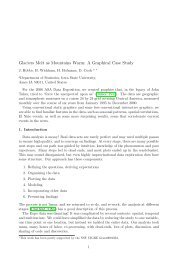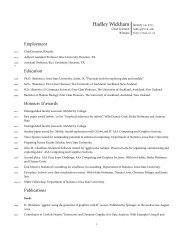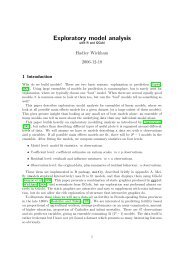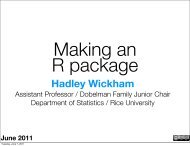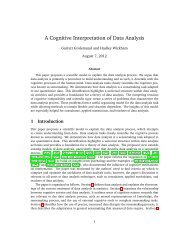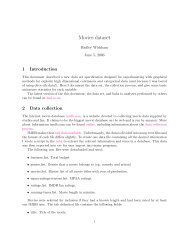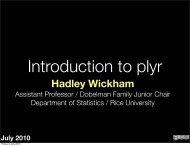Stat310: Test 1 Answer the questions in the spaces provided on the ...
Stat310: Test 1 Answer the questions in the spaces provided on the ...
Stat310: Test 1 Answer the questions in the spaces provided on the ...
Create successful ePaper yourself
Turn your PDF publications into a flip-book with our unique Google optimized e-Paper software.
Name:<br />
<str<strong>on</strong>g>Stat310</str<strong>on</strong>g>: <str<strong>on</strong>g>Test</str<strong>on</strong>g> 1<br />
<str<strong>on</strong>g>Answer</str<strong>on</strong>g> <str<strong>on</strong>g>the</str<strong>on</strong>g> <str<strong>on</strong>g>questi<strong>on</strong>s</str<strong>on</strong>g> <str<strong>on</strong>g>in</str<strong>on</strong>g> <str<strong>on</strong>g>the</str<strong>on</strong>g> <str<strong>on</strong>g>spaces</str<strong>on</strong>g> <str<strong>on</strong>g>provided</str<strong>on</strong>g> <strong>on</strong> <str<strong>on</strong>g>the</str<strong>on</strong>g> questi<strong>on</strong> sheets. If you<br />
run out of room for an answer, c<strong>on</strong>t<str<strong>on</strong>g>in</str<strong>on</strong>g>ue <strong>on</strong> <str<strong>on</strong>g>the</str<strong>on</strong>g> back of <str<strong>on</strong>g>the</str<strong>on</strong>g> page.<br />
You have 80 m<str<strong>on</strong>g>in</str<strong>on</strong>g>utes and you may use <strong>on</strong>e double-sided page of notes. You<br />
may not use your text book or a computer (calculators are f<str<strong>on</strong>g>in</str<strong>on</strong>g>e). Please<br />
pledge <strong>on</strong> <str<strong>on</strong>g>the</str<strong>on</strong>g> last page.<br />
1. I call my bank and <str<strong>on</strong>g>the</str<strong>on</strong>g> record<str<strong>on</strong>g>in</str<strong>on</strong>g>g tells me <str<strong>on</strong>g>the</str<strong>on</strong>g>re are 4 people ahead of me. I know <strong>on</strong> average that a call<br />
takes 3 m<str<strong>on</strong>g>in</str<strong>on</strong>g>utes.<br />
(a) How l<strong>on</strong>g do I expect to wait? Why?<br />
(2)<br />
(b) What is a plausible distributi<strong>on</strong> for <str<strong>on</strong>g>the</str<strong>on</strong>g> amount time a s<str<strong>on</strong>g>in</str<strong>on</strong>g>gle call takes? Justify your choice.<br />
(3)<br />
(c) If I had a way of generat<str<strong>on</strong>g>in</str<strong>on</strong>g>g random numbers from a uniform distributi<strong>on</strong>, how could I use <str<strong>on</strong>g>the</str<strong>on</strong>g>m to (2)<br />
simulate from distributi<strong>on</strong> <str<strong>on</strong>g>in</str<strong>on</strong>g> b?<br />
(d) Let N be <str<strong>on</strong>g>the</str<strong>on</strong>g> number of calls <str<strong>on</strong>g>the</str<strong>on</strong>g> bank receives <str<strong>on</strong>g>in</str<strong>on</strong>g> an hour. What’s a plausible distributi<strong>on</strong> for N?<br />
(3)
2. The follow<str<strong>on</strong>g>in</str<strong>on</strong>g>g probability <str<strong>on</strong>g>questi<strong>on</strong>s</str<strong>on</strong>g> require you to explore some <str<strong>on</strong>g>in</str<strong>on</strong>g>terest<str<strong>on</strong>g>in</str<strong>on</strong>g>g f<str<strong>on</strong>g>in</str<strong>on</strong>g>d<str<strong>on</strong>g>in</str<strong>on</strong>g>gs about birthdays.<br />
(a) If <str<strong>on</strong>g>the</str<strong>on</strong>g>re are 5 people <str<strong>on</strong>g>in</str<strong>on</strong>g> a room, what is <str<strong>on</strong>g>the</str<strong>on</strong>g> probability that any two of <str<strong>on</strong>g>the</str<strong>on</strong>g>m share a birthday? (3)<br />
(H<str<strong>on</strong>g>in</str<strong>on</strong>g>t: start by figur<str<strong>on</strong>g>in</str<strong>on</strong>g>g out <str<strong>on</strong>g>the</str<strong>on</strong>g> probability that n<strong>on</strong>e of <str<strong>on</strong>g>the</str<strong>on</strong>g>m share a birthday)<br />
(b) If <str<strong>on</strong>g>the</str<strong>on</strong>g>re are n people <str<strong>on</strong>g>in</str<strong>on</strong>g> room, what is <str<strong>on</strong>g>the</str<strong>on</strong>g> probability that any two of <str<strong>on</strong>g>the</str<strong>on</strong>g>m share a birthday?<br />
(2)<br />
(c) (5)<br />
There are some <str<strong>on</strong>g>in</str<strong>on</strong>g>terest<str<strong>on</strong>g>in</str<strong>on</strong>g>g seas<strong>on</strong>al patterns <str<strong>on</strong>g>in</str<strong>on</strong>g> birth date: while unmarried mo<str<strong>on</strong>g>the</str<strong>on</strong>g>rs are equally<br />
likely to give birth <str<strong>on</strong>g>in</str<strong>on</strong>g> any seas<strong>on</strong>, married mo<str<strong>on</strong>g>the</str<strong>on</strong>g>rs are more likely to give birth <str<strong>on</strong>g>in</str<strong>on</strong>g> spr<str<strong>on</strong>g>in</str<strong>on</strong>g>g and less<br />
likely to give birth <str<strong>on</strong>g>in</str<strong>on</strong>g> w<str<strong>on</strong>g>in</str<strong>on</strong>g>ter. Assume that <strong>on</strong>ly 0.075 of married mo<str<strong>on</strong>g>the</str<strong>on</strong>g>rs give birth <str<strong>on</strong>g>in</str<strong>on</strong>g> w<str<strong>on</strong>g>in</str<strong>on</strong>g>ter and<br />
about 30% of babies are born to unmarried mo<str<strong>on</strong>g>the</str<strong>on</strong>g>rs. Given that a child was born <str<strong>on</strong>g>in</str<strong>on</strong>g> w<str<strong>on</strong>g>in</str<strong>on</strong>g>ter, what’s<br />
<str<strong>on</strong>g>the</str<strong>on</strong>g> probability that <str<strong>on</strong>g>the</str<strong>on</strong>g>ir mo<str<strong>on</strong>g>the</str<strong>on</strong>g>r was married?
3. I’ve decided to decorate my office by pa<str<strong>on</strong>g>in</str<strong>on</strong>g>t<str<strong>on</strong>g>in</str<strong>on</strong>g>g randomly sized dots <strong>on</strong> <str<strong>on</strong>g>the</str<strong>on</strong>g> wall. For each dot, I randomly<br />
choose <str<strong>on</strong>g>the</str<strong>on</strong>g> radius by draw<str<strong>on</strong>g>in</str<strong>on</strong>g>g it from a exp<strong>on</strong>ential distributi<strong>on</strong> with mean 5. Some selected values of<br />
<str<strong>on</strong>g>the</str<strong>on</strong>g> cdf are shown <str<strong>on</strong>g>in</str<strong>on</strong>g> <str<strong>on</strong>g>the</str<strong>on</strong>g> table below.<br />
X P (X ≤ x)<br />
1 0.18<br />
2 0.33<br />
3 0.45<br />
4 0.55<br />
5 0.63<br />
6 0.70<br />
7 0.75<br />
8 0.80<br />
9 0.83<br />
10 0.86<br />
X P (X ≤ x)<br />
11 0.89<br />
12 0.91<br />
13 0.93<br />
14 0.94<br />
15 0.95<br />
16 0.96<br />
17 0.97<br />
18 0.97<br />
19 0.98<br />
20 0.98<br />
(a) What’s <str<strong>on</strong>g>the</str<strong>on</strong>g> probability that <str<strong>on</strong>g>the</str<strong>on</strong>g> radius of a dot is between 10 and 20cm?<br />
(2)<br />
(b) What’s <str<strong>on</strong>g>the</str<strong>on</strong>g> approximate probability that <str<strong>on</strong>g>the</str<strong>on</strong>g> area of a dot lies between 100 and 300 cm (2)<br />
2 ?<br />
(c) What size area do I need to leave blank to guarantee that at least 95% of <str<strong>on</strong>g>the</str<strong>on</strong>g> dots will fit <str<strong>on</strong>g>in</str<strong>on</strong>g>?<br />
(2)
(d) Work out <str<strong>on</strong>g>the</str<strong>on</strong>g> pdf for A, <str<strong>on</strong>g>the</str<strong>on</strong>g> area of each dot<br />
(4)<br />
4. Let f(x) = 1<br />
2be−|x|/b , x ∈ (−∞, ∞), b > 0. (H<str<strong>on</strong>g>in</str<strong>on</strong>g>t: if you get stuck, try sketch<str<strong>on</strong>g>in</str<strong>on</strong>g>g a plot of f(x))<br />
(a) Verify that f(x) is a pdf.<br />
(5)<br />
(b) Without us<str<strong>on</strong>g>in</str<strong>on</strong>g>g calculus, argue that <str<strong>on</strong>g>the</str<strong>on</strong>g> mean is 0.<br />
(2)
(c) Complete <str<strong>on</strong>g>the</str<strong>on</strong>g> steps below to work out <str<strong>on</strong>g>the</str<strong>on</strong>g> mgf.<br />
(3)
Pledge:<br />
Questi<strong>on</strong> Po<str<strong>on</strong>g>in</str<strong>on</strong>g>ts Score<br />
1 10<br />
2 10<br />
3 10<br />
4 10<br />
Total: 40



